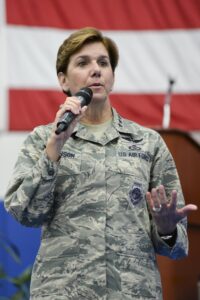
Chinese J-31 stealth fighter
AFA CONFERENCE: China’s increasing assertiveness and modernizing military are “concerning,” even “disconcerting,” the head of the US Air Force in the Pacific said today. But there are still strong prospects for military-to-military ties, Gen. Lori Robinson told the Air Force Association conference here this morning.
Increased Russian patrols complicates US strategy more, Gen. Robinson told me when I buttonholed her after her AFA remarks. Being based up north in Siberia, she said, “Russian long-range aviation has to go a ways before it really challenges us a lot, but [they’re] putting themselves into the theater, and as they circumnavigate Japan or circumnavigate Guam, that’s a challenge.”

Gen. Lori Robinson
“They’re allowed to fly in that airspace. It’s international airspace,” Robinson noted. “But it’s new” that the Russians are exercising that right.
That said, China is obviously the once and future giant of the Pacific. Robinson is “watching how’s China closing that capability gap between us and them,” she told me. She’d told the AFA audience that “I get incredibly concerned about the capability gap decreasing [between the US and other nations]. That technology gap continues to get smaller and smaller, and for us that should be very disconcerting.”
With me, Robinson stressed the oft-overlooked distinction between what the military means by capability — the things a force can do — and what it means by capacity — how much it can do them. Capacity the Chinese have already got, in spades. We can’t match the world’s most populous nation on quantity, so we have to beat them on quality. But Chinese capability gains call that balance into question.
“Their capacity has increased over time, and ours has been pretty stable. So that’s why we rely so much on capability and great airmen,” Robinson told me. “If their capability gets closer to ours,” while their capacity remains much larger, she said, “that poses a challenge.”
On one of her visits to China, Robinson told the AFA audience, she got to see the J-31 stealth fighter, the one that looks suspiciously like the stolen schematics for the F-35 Joint Strike Fighter. But the Chinese aren’t just interested in our technology: They’re interested in our people as well, especially our long-serving corps of non-commissioned officers, for which there’s no Chinese equivalent. At one event, she recalled, Chinese servicemembers asked in fascination about the chevrons on the sleeves of American NCOs. The conversation led to a real human connection between the two countries’ personnel.
US and China have plenty of opportunities in the Pacific to work side by side for common purposes, Robinson said. “They were in Nepal during the earthquake,” she noted.
In a region prone to earthquakes, tsunamis, and monsoon floods, humanitarian assistance and disaster relief (HADR) drive much of America’s work with all its Pacific partners. The heart of Robinson’s presentation to AFA, in fact, was a litany of HADR exercises.
But not all those exercises are humanitarian: Some are wargames. Japanese F-15s have worked together with American F-22s, Robinson emphasized. In the huge annual Red Flag exercise, Robinson noted, “We had US E-3 [AWACS], Australian Wedgetail, and a Japanese 767″ performing command-and-control. “It was incredible.”
That kind of complex flying network is a major advantage in aerial warfare. It’s also an area where China still lags behind — at least for now.
Navy jet trainer fleet operations remain paused after engine mishap
One week after the incident, a Navy spokesperson says the service is continuing to assess the fleet’s ability to safely resume flight.


























